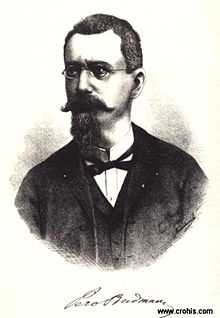Pero Budmani
| Pero Budmani | |
|---|---|
 | |
| Born |
October 27, 1835 Dubrovnik, Kingdom of Dalmatia, Austria-Hungary (today's Croatia) |
| Died |
December 27, 1914 Castel Ferretti, Ancona, Kingdom of Italy (1861–1946) (today's Italy) |
| Pen name | P.B. |
| Occupation | linguist and philologist |
| Notable works | Grammatica della lingua serbo-croata (illyrica). |
Pero Budmani (October 27, 1835 - December 27, 1914) was a writer, linguist, grammarian, and philologist from Dubrovnik and a renowned polyglot. Budmani was instrumental in the emergence of the second group of Serb Catholics in the 1880s.
Biography
Budmani was born in Dubrovnik/Ragusa on the 27th of October 1835.
Budmani was one of the first persons to have used the combined term Croatian and Serbian into "Serbo-Croat (Illyrian)". . It was first used by the German Jacob Grimm in 1824 and the Austrian-Slovenian Slavist Jernej Kopitar in 1836. [1] He wrote a seminal book in Italian called Grammatica della lingua serbo-croata (illyrica) that described the Serbo-Croatian grammar, published in Vienna in 1867. Because it was written primarily as a manual for use in the gymnasia in Dalmatia, it was restricted in scope and space, but it soon received high praise from Đuro Daničić in Rad JAZU #2 in 1868. Budmani's description of the limited use of aorist and imperfect and the subtleties of perfect was consistent with Croatian vernacular at the time.[2]
Between 1868 and 1882, he taught in the Gymnasium (high school) of his hometown. In 1883 he reached Zagreb where he edited the Riječnik (Dictionary) of the Yugoslav Academy of Sciences and Arts, based in Zagreb, Croatia, then part of Austria-Hungary. He was also a corresponding member of both the Serbian Learned Society (inducted: January 24, 1871) and the Serbian Royal Academy (from January 23, 1888).
Pero Budmani was one of the prominent members of the Serb Catholic movement in Dubrovnik.[3] He is credited for the emergence of the movement together with another professors of the secondary school in Dubrovnik, Stjepo Castrapelli. He was a member the Municipal Council of Dubrovnik. In their March 9, 1880 session, the Council adopted the proposition of the Dubrovnik Youth to raise a monument that would commemorate the 300th anniversary of the birth of Ivan Gundulić. Budmani was named in the committee that would oversee the construction of the monument, together with Medo Pucić, Antun Fabris, Ivo Kaznačić, Mato Vodopić and Luko Zore. The unveiling of the Gundulić monument in Dubrovnik took place on May 20, 1893, and it turned out to be a major political event that confronted the Croat and Serb political parties in Dubrovnik.
In 1907 he returned to Italy to Castelferretti and lived there until 1913 years when he returned to his native Dubrovnik. But already the following year, seriously ill and embittered for the persecution suffered at the hands of the Austrian police (who considered him a dangerous subversive), Pero Budmani fled from home, reached Ancona and died there on December 27, 1914.
Budmani spoke most of the European languages, including Old Slavonic, Greek, Latin, and several Asiatic languages.
Works
References
- ↑ Okuka, M. 1998. Eine Sprache - viele Erben. Sprachpolitik als Nationalisierungsinstrument in Ex-Jugoslawien. Klagenfurt: Wieser Verlag, S. 16.
- ↑ Peti, Mirko (June 1985). "Pogledi jugoslavenskih lingvista na sintaksu vremena". Rasprave Instituta za hrvatski jezik i jezikoslovlje (in Croatian) (Institute of Croatian Language and Linguistics). 10-11 (1): 110–111. ISSN 1331-6745. Retrieved 2012-03-27.
- ↑ "'PITANJE BOŠKOVIĆA' Dr. Nikola Tolja: Posrbljenje Dubrovčana bio je čin otpora Beču i Pešti" (in Croatian). 2012-02-07. Retrieved 2012-03-27.
|